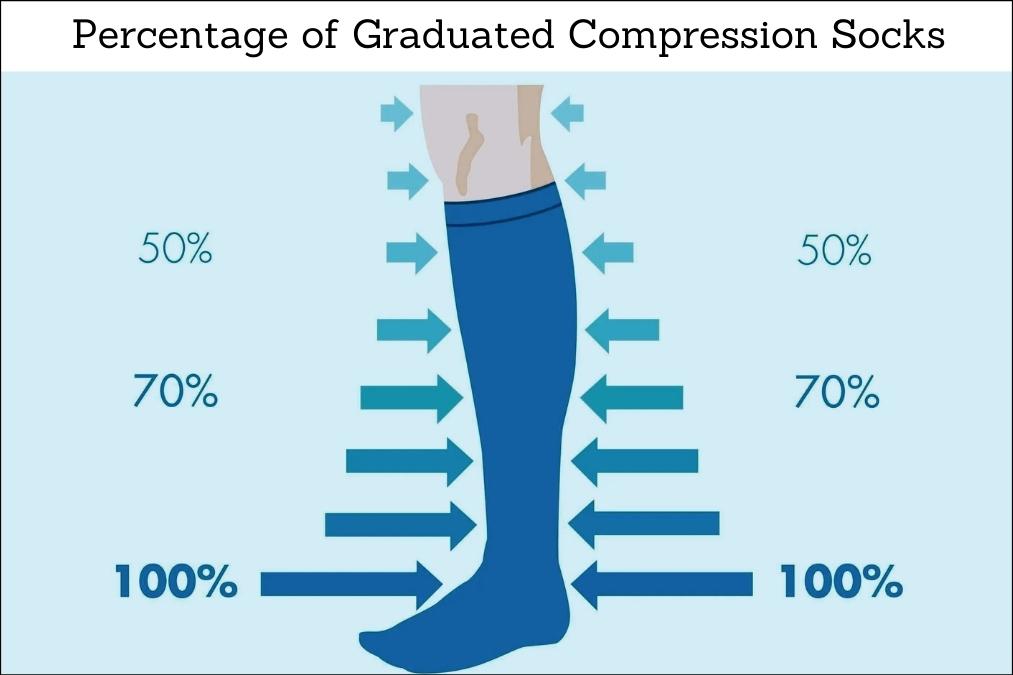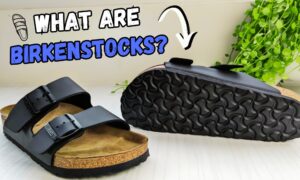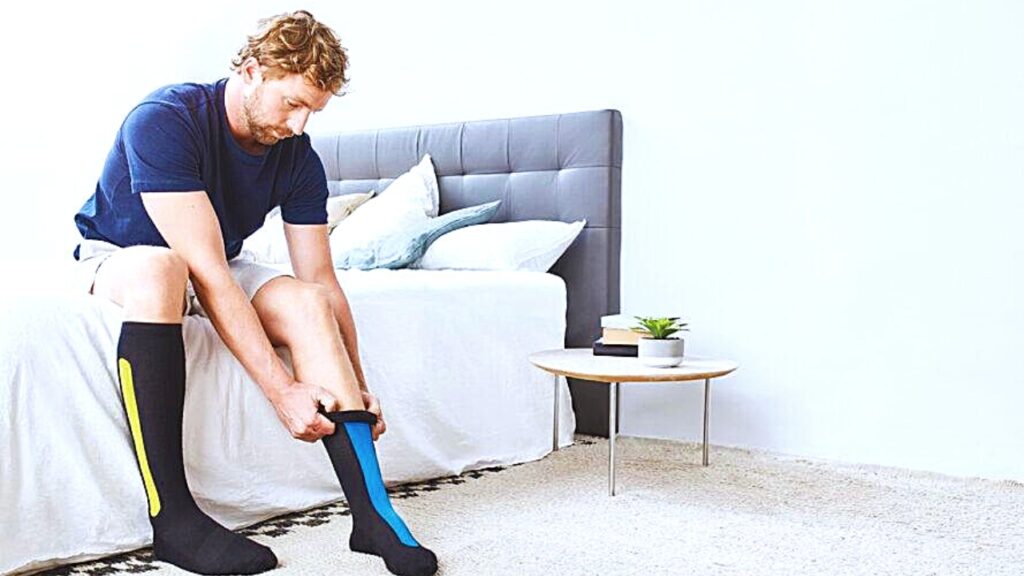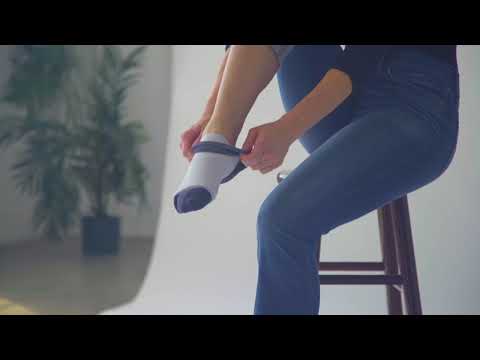How Long Can You Wear Compression Socks? A Guide to Wearing Compression Socks
Compression socks are specially designed to provide support and improve circulation to the legs for athletes during physical activities. They can also be worn by individuals with medical conditions such as swelling and deep vein thrombosis (DVT)
But do you know how long can you wear compression socks? In this comprehensive guide, we will give you the right answer to this question and provide valuable information to help you know all the necessary details about compression socks, So read on to discover what are compression socks, What are their types, How long you can wear them and much more.
What are Compression Socks?
At their most basic, compression socks are a type of hosiery that cover the feet and lower part of the leg. Unlike regular socks, Compression socks are designed to provide graduated compression to the legs, ankles and feet
The pressure applied to these areas helps to improve blood flow so that reducing the risk of blood clots varicose veins and other circulation problems. They are typically made of a stretchy, breathable material that is designed to fit snugly around the leg without causing discomfort
They also come in different levels of compression ranging from mild to extra-firm, The level of compression is measured in millimeters of mercury (mmHg) which is the same unit used to measure blood pressure compression socks are available in a variety of types, too

Types of Compression Socks
Compression Socks are specially designed to provide graduated pressure to the legs, feet and ankles, so that improving blood circulation. There are several types of compression socks, each with its own unique features and benefits:
-
1- Graduated Compression Socks
These socks feature the highest compression around the ankle. and gradually decrease as they move up to the calf or knee This helps to increase blood flow and prevent blood clots.
-
2- Anti-Embolism Compression Socks
These Socks are designed for patients who are immobile or bedridden preventing blood clots and deep vein thrombosis. These socks provide a consistent pressure throughout the length of the sock to promote blood flow and prevent blood clots.
-
3- Athletic Compression Socks
These socks are designed for athletes or individuals who participate in multiple types of physical activity such as running, cycling, and weightlifting. They provide targeted compression to specific muscle groups, reduce muscle vibration and enhance blood circulation.
-
4- Travel Compression Socks
These socks are designed for people who travel for long hours by plane, train or car. They help prevent swelling, fatigue and DVT during long periods of sitting or standing.
-
5- Medical Compression Socks
These socks are designed for individuals with medical conditions such as varicose veins, swelling or even chronic venous insufficiency and other circulation-related problems. These socks provide higher pressure than graduated compression socks and are available in different levels of compression.
-
6- Maternity Compression Socks
These socks are designed for pregnant women, they provide support to the legs, hips and back
They also help to reduce swelling and discomfort during pregnancy regardless of the type of compression socks you choose, it is important to choose a pair that fits well and provides the level of compression you need. Consult with a medical professional or fitness expert if you need help.
How Long Can You Wear Compression Socks?
The duration for which you can wear compression socks varies depending on the type of socks you are wearing and the reason for wearing them:
-
1- For Graduated Compression Socks
Graduated compression socks are usually worn for extended periods, especially for individuals with medical conditions
These socks can be worn for up to 8-12 hours a day, depending on the patient’s condition and comfort level
-
2- For Athletic Compression Socks
Athletic compression socks can be worn during physical activity and for a few hours after the activity to aid in recovery.
It is recommended to wear them for up to 24 hours after intense physical activity and then remove them to allow your skin to breathe.
-
3- For Anti-Embolism Compression Socks
Patients who are immobile or bedridden can wear these anti-embolism compression socks for 18-24 hours a day depending on their medical condition and comfort level
-
4- For Travel Compression Socks
Travel compression socks can be worn for several hours or even days depending on the duration of your travel, the mode of transportation and the distance traveled. It is essential to take breaks and allow your skin to breathe, especially during any layovers or breaks in your travel.
-
5- For Medical Compression Socks
Individuals with medical conditions such as varicose veins or swelling can wear these socks for up to 12 hours a day depending on the level of compression and the individual’s needs. Consult with a medical professional or fitness expert if you need any help regarding how long you should wear these medical compression socks.
-
6- For Maternity Compression Socks
Maternity compression socks can be worn throughout the day, depending on the individual’s needs and comfort level. It is recommended to remove the socks and allow your skin to breathe, especially during extended periods of sitting or standing.
In general, compression socks are considered safe for most individuals when used appropriately but it is always best to consult with a medical professional to know how long you can wear them
It is important to note that you should never wear compression socks for more extended periods than recommended.
Prolonged use of compression socks without allowing your skin to breathe can cause negative side effects like skin irritation, redness and even blood clots so be careful!
Benefits of Wearing Compression Socks
There are several benefits to wearing compression socks, including
-
1- Improved Circulation:
Compression socks work by providing gentle pressure to the legs, ankles, and feet. The pressure applied to these areas helps to improve blood flow and circulation This increased blood flow can in turn help to reduce fatigue and improve athletic performance.
-
2- Reduce Swelling
Compression socks can help to reduce swelling in the legs, ankles and feet. This is especially beneficial for people who stand or sit for long periods
-
3- Provide Comfort
Compression socks are made from a blend of materials that are designed to be comfortable to wear even during intense physical activity They are designed to fit snugly around the legs without causing discomfort
Added to that, the moisture-wicking properties help to keep the skin dry and comfortable.
-
4- Prevent Injury
Athletic compression socks are designed specifically for active individuals These socks provide support to the muscles and reduce the risk of injury. They are typically made from lightweight and breathable material, too.
-
5- Aid in Recovery
The graduated compression provided by these socks helps to reduce muscle soreness and improve recovery time after physical activity. This can be especially beneficial for athletes and individuals who engage in high-impact activities.
-
6- Improve Overall Health:
Compression socks are designed to apply gentle pressure to the legs, ankles and feet which helps to improve blood flow, reduce swelling, prevent deep vein thrombosis (DVT) and even blood clots and other related health issues.
Tips for Wearing Compression Socks
Compression socks are designed to provide support to the muscles and increase circulation.
How long you can wear your compression socks depends on several factors such as the material, the level of compression and the purpose for wearing them. To ensure that you get the most out of your compression socks. here are some tips to follow:
-
Choose The Right Size:
It’s important to choose the right size of your compression socks for a comfortable and supportive fit. A poorly fitting sock can cause discomfort, skin irritation and even worsen circulation.
-
Wear Them Correctly:
Make sure to put them on correctly starting at the foot and gradually pulling up to the leg. Smooth out any wrinkles or lunching to ensure even pressure distribution
-
Take Breaks:
Generally, it’s recommended to wear compression socks for extended periods a day, as wearing them for longer periods can lead to decreased circulation and discomfort.
So, It’s important to take breaks and remove the socks to allow your skin to breathe and prevent skin irritation.
-
Replace Regularly:
Over time, compression socks can lose their elasticity or the level of compression and become less effective. So it’s recommended to replace them every 3-6 months, depending on how often you wear them.
-
Consult A Healthcare Provider:
It’s always best to consult with your doctor or a physical therapist to determine the best wearing schedule and compression level for your specific needs.
How To Put On and Take Off Compression Socks
To learn the best techniques for putting on compression socks, we are here to guide you with step-by-step instructions specifically for putting on knee-length compression socks:
- Place your hand and arm inside the compression sock, grasping the heel.
- Turn the top of the sock inside out, creating a pocket for your foot.
- Gently slide your toes into the foot portion of the sock.
- Wiggle your foot and toes until your heel aligns with the heel of the sock.
- Hold the cuff of the sock and gradually pull it up your leg.
- Smooth out any wrinkles or bunching, ensuring that the cuff rests just below your knee.
- Avoid folding or rolling down the cuff, as it may interfere with the compression effect.
- Some individuals find it helpful to use specialized tools like a sock donner or donner gloves to simplify the process of putting on compression socks.
When it comes to taking off the socks, it is advisable to be in a seated position to maintain stability. Follow these steps:
- Grasp the cuff of the sock with both hands.
- With a fluid motion, carefully pull the sock off your leg, removing it entirely.
By following these instructions, you can effectively and comfortably put on and take off your compression socks, maximizing their benefits and ensuring a proper fit.
Who Should Avoid Wearing Compression Socks?
It’s important to be aware of certain symptoms and medical conditions that may warrant avoiding the use of compression socks. If you experience any of the following symptoms while wearing compression socks, it is recommended to remove them:
- Corns
- Loss of circulation
- Allergic skin reactions
- Tingling feet
- Discomfort
- Joint pain
- Redness
Additionally, individuals with the following medical conditions should consult a doctor before considering compression therapy:
- Diabetes
- Peripheral neuropathy
- Skin infection
- Ischaemia
- Congestive heart failure
Risks of Wearing Compression Socks for Extended Periods
Wearing compression socks can provide various benefits such as improving blood circulation, reducing fatigue, preventing varicose veins, etc. However, if they are used unproperly and carelessly, they can have negative side effects such as:
-
Skin Irritation:
Compression socks can lead to skin irritation especially if they are too tight or if you have sensitive skin so it’s always recommended to choose the right size and material of compression socks and avoid wearing them for longer periods a day.
-
Numbness and Tingling:
Wearing compression socks for too long and without allowing breaks to the legs may cause numbness and tingling. This because the compression may be too tight and restrict blood flow.
-
Blood Clots:
While compression socks help prevent blood clots, wearing them for longer periods a day may increase the risk of blood clots in some people and this is due to the fact that too tight compression socks may restrict blood flow and cause blood to pool in the legs.
Whether your goal is to proactively prevent vascular issues or enhance post-workout recovery, compression socks provide a convenient and affordable means to achieve your wellness objectives. Compression therapy has been scientifically validated and can significantly improve how you feel.
So, when you’re getting ready in the morning, consider reaching for the sock that can help unlock your full potential. Compression is a simple yet effective way to enhance your well-being and maintain optimal health throughout the day, every day.
Other Frequently Asked Questions (FAQs) About How Long Should You Wear Compression Socks
-
Q1: Can You Wear Compression Socks Safely Throughout the Day?
A: Unless you have any of the contraindications mentioned earlier, wearing compression socks all day is generally safe. Many professionals, including athletes, doctors, pilots, engineers, and chefs, rely on compression socks to alleviate job-related discomfort and promote a sense of well-being.
-
Q2: How Long Can You Wear Compression Socks for Shin Splints?
A: The duration of wearing compression socks for shin splints can vary depending on the severity of the condition and individual circumstances. In general, it is recommended to wear compression socks during activities that aggravate shin splints, such as running or exercising, to provide support and alleviate discomfort.
For some individuals, wearing compression socks during the activity that triggers shin splints may be sufficient, and they can remove the socks afterward. In this case, the duration would be limited to the time spent engaging in the activity.
However, for others with more persistent or chronic shin splints, wearing compression socks throughout the day, even during periods of rest, may be advised. In such cases, the duration may be extended to several hours or even the entire day.
The key is to listen to your body and follow the recommendations of a healthcare professional, such as a sports medicine specialist or physical therapist. They can assess your condition, provide personalized advice, and determine the appropriate duration of wearing compression socks for shin splints to support your recovery and overall well-being.
-
Q3: How Long Should You Wear Compression Socks for Swollen Feet
A: The duration of wearing compression socks for swollen feet can vary based on the severity of the swelling and the underlying cause. It’s essential to consult with a healthcare professional to determine the appropriate duration for your specific situation. In general, the following guidelines may apply:
- Acute Swelling: If the swelling is a result of a recent injury or acute condition, wearing compression socks during the day and removing them at night while resting may be recommended. The compression can help reduce swelling and promote circulation during activity.
- Chronic Swelling: If you experience chronic or persistent swelling in your feet, your healthcare provider might advise wearing compression socks for longer periods, possibly throughout the day. However, it’s crucial to take breaks and remove the socks periodically to allow your feet to rest.
- Medical Conditions: If the swelling is related to a specific medical condition, such as lymphedema, venous insufficiency, or edema, your healthcare provider will provide specific instructions regarding the appropriate duration and frequency of wearing compression socks.
- During Prolonged Sitting or Standing: If you are prone to swelling during extended periods of sitting or standing (e.g., during long flights or work shifts), wearing compression socks during these times can help prevent or reduce swelling.
Always follow the advice of your healthcare professional and, if possible, have the compression socks properly fitted to ensure optimal effectiveness and comfort.
-
Q4: How Long Should You Wear Compression Socks After Surgery?
A: The duration of wearing compression socks after surgery can vary depending on the type of surgery and the recommendation of your surgeon. In some cases, you may be advised to wear compression socks for a few weeks or even months post-surgery to prevent blood clots and promote healing. Always follow the specific instructions given by your healthcare provider.
-
Q5: Should You Wear Compression Socks While Sleeping?
A: It is generally not recommended to wear compression socks while sleeping. Here’s why:
- Potential circulation issues: When you are asleep, you may not be aware if the sock becomes bunched or folded over, which can potentially restrict circulation. While you would likely notice this issue while awake and adjust the sock, you may sleep through the discomfort, leading to potential medical problems.
- Reduced need for assistance: When you are reclined in bed, your veins do not require as much assistance in pumping blood against gravity compared to when you are upright and active. This means that the benefits of wearing compression socks, such as reduced swelling and discomfort, are more pronounced during waking hours.
It is important to note that wearing compression socks during the day, while moving around, standing, or sitting upright, can provide significant benefits. Graduated compression socks, which exert more pressure at the ankles and gradually decrease towards the top, are often recommended for these activities.
If you have specific concerns or medical conditions that require compression therapy while sleeping, it is essential to consult with a healthcare professional who can provide personalized advice based on your needs.








